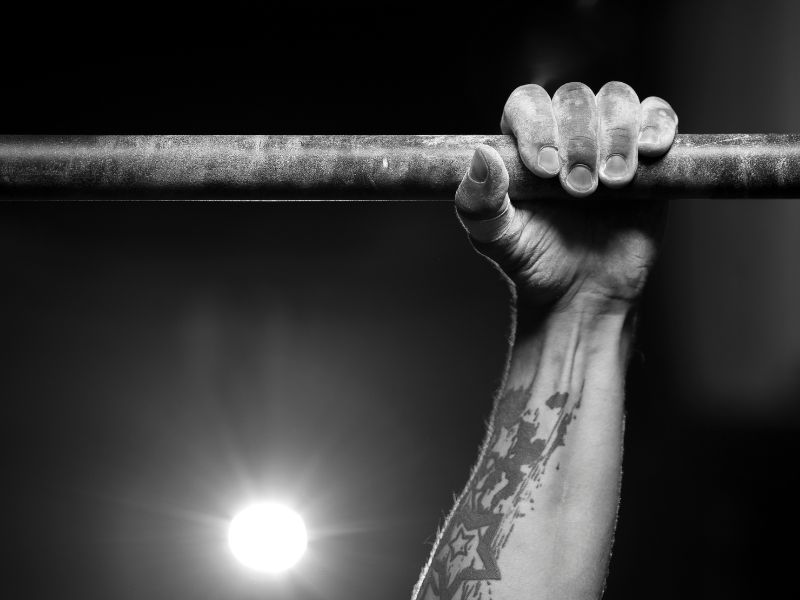A pull-up bar for your home gym is an excellent investment. There’s no better way to optimize your space than to use your body weight to hit your back and lats.
That said, when shopping for a pull-up bar, many face a dilemma when they realize they come in different diameters. So, what is the best pull-up bar diameter?
The best pull-up bar diameter will be the standard size for most people. That’s 1.10-1.26 inches (28-32mm). However, the right choice depends on your body size and goals. A wider diameter is great for training grip strength, whereas a smaller diameter is best for those with smaller hands.
While that’s the gist of the decision, there’s a lot more to consider here. I’ll break it all down in a way that’s easy to understand in the rest of this guide. Keep reading to get all the details.
Understanding Pull-Up Bar Diameter
When choosing a pull-up bar diameter, it’s essential to understand what it is and how it affects things. Essentially, the diameter of your pull-up bar is a measurement of its width. It affects how far your hands have to stretch around it to get a good grip. A smaller diameter means you’ll be able to grip it easier, whereas a wider diameter will be much harder to grip.
If you’re doing pull-ups to build your back and lats, you’ll likely not want to have grip as a limiting factor. That means going with a diameter that is easy for you to grip will be a better bet.
On the other hand, others may want to train specifically for grip strength. Then, having a wider diameter will be a better fit.
For context, the army pull-up test uses a standard diameter of 1.25 inches. They find that to be the best fit for someone to demonstrate their overall strength. So, if you’re going for a balance between grip development and back strength (which most people should), then standard will work best.
Common Pull-Up Bar Diameters
Here’s a quick overview of your options when picking a pull-up bar diameter.
| Diameter | Diameter (inches) | Pros | Cons |
| Thin (25-28mm) | 0.98-1.10″ | Easier to grip, good for those with smaller hands, and good for those with low grip strength. | Those with larger hands may feel some discomfort using a bar diameter that’s too thin. |
| Standard (28-32mm) | 1.10-1.26″ | Comfortable grip for most people. Provides balance for overall strength development for grip and back/lats during pull-ups. | Those with smaller hands or weaker grip strength may struggle with this diameter. |
| Thick (32mm+) | 1.26″+ | Helps improve grip strength. Provides a more challenging workout. | Limits the number of pull-ups you can do for back development. Frequent use of thick diameters can cause pain in fingers or palms for some people. |
Breaking Down the Pros and Cons of Different Diameters
Now that you have a basic idea of the different diameters let’s discuss the pros and cons of each one in more detail.
Thin Diameter: 0.98-1.10″ (25-28mm)
The thin diameter will be best for those with smaller hands or lower grip strength. If you have a smaller build and often find that your grip fails quickly on a standard pull-up bar, give this option a shot.
If your goal is overall back and lat development rather than forearms and grip, you may think the thin diameter is the ultimate option to do as many pull-ups as possible for each set.
However, there is one drawback for some people. If you have larger hands, doing pull-ups on a bar that’s too thin can cause pain in the palms or fingers. Plus, it can lead to imbalances later on if your grip and forearm muscles become underdeveloped. Keep those aspects in mind while making your decision.
Standard Diameter: 1.10-1.26″ (28-32mm)
As mentioned earlier, the standard diameter works best for most people. It provides balanced strength development between the grip and your back/lats.
A standard diameter is often easier to find since most pull-up bars up for sale will be in this range. It’s an added benefit that you should be able to find one quickly.
The only real drawback is those with smaller hands won’t be able to grip it as well. So, if you’re in that boat, look to the previously mentioned thin diameter to be your solution.
Thick Diameter: 1.26”+ (32mm+)
Thick-diameter bars have a wider range from 1.26 to 2 inches in diameter. It’ll be important to decide how intensely you want to work your grip when choosing thicker bars.
This diameter is best for those who want to maximize their grip strength. For instance, those struggling with grip on deadlifts or rows and wanting to train it specifically to improve those lifts. Or someone who does sports like climbing or arm wrestling where grip is extremely important.
For many people, buying a thick-diameter pull-up bar may be an “extra.” That’s especially true if you still want to do standard pull-ups in your routine. It may lead you to end up buying a thick pull-up bar and a standard-sized one.
You also want to be careful because some people who do too much grip training will end up with pain in the fingers or palms. I ran into this myself a few months ago. I was doing a lot of thick bar pull-ups, and suddenly, my fingers and palms started to feel very achy. Once I reduced the volume I was doing, that pain went away. So, you need to find a balance there.
Choosing the Right Diameter for You
Finally, let’s review a few key factors that’ll help you pick the correct diameter.
Hand Size
Here’s a quick breakdown if you’re wondering which hand sizes fit different pull-up bar diameters. The measurements here are done from the bottom of your palm to the tip of your longest finger.
- Small hands: Small hands will typically be under 8 inches in length. If that’s you, it may be a sign you would benefit from a smaller diameter on your pull-up bar.
- Average hands: An average hand size is between 8-10 inches. If that’s you, then a standard pull-up bar diameter is probably the way to go.
- Large hands: Large hands can range from 10 inches to up to 13.5 inches. Some on the lower end of this range will still feel better on a standard pull-up bar diameter. However, in rarer instances where your hands are 12-13.5 inches long, you may feel better on a thicker bar. Go by personal preference and feel here.
If your hand size lands in one of these categories and the recommended bar doesn’t feel like quite the right fit, don’t worry. Try out some different-sized bars and go with the option that feels best for you.
Do You Have Reps Left in the Tank When Your Grip Fails?
The average person doing pull-ups on a bar that’s the right diameter should have their back, lats, and arms feel like they’re failing before grip. If you’re losing grip early and feel like you have many reps left in the tank, it may be a sign that a smaller diameter will work better.
Training for Different Sports
Another consideration is if you want to do training that carries over to sport-specific needs. Some sports will benefit from you having a stronger grip, such as:
- Arm-wrestling
- Climbing
- Powerlifting
- Strongman
- Martial arts
- Basketball
- Baseball
- Football
If you’re looking to increase your grip strength for better performance in sports like these, doing pull-ups on a thicker bar may be a great solution.
Alternative Solution
One alternative solution I wanted to throw in at the very end here is Fat Gripz. They’re an attachment you can add to standard-sized bars to increase the diameter when you want to do thick bar pull-ups.
I use them often for pull-ups and other exercises like rows, deadlifts, or rack pulls when the goal of the training session is grip strength.
Adding Fat Gripz that you can easily take on and off will help save you from buying multiple pull-up bars in different diameters.
Conclusion
That’s a wrap on this one. By now, you should have a good idea of different pull-up bar diameter options and how they can impact your training sessions. All that’s left to do is try some out and see what works best for you. Once you have that down, you’ll be on your way to increasing your pull-ups and building your back muscles in the process.
Thanks for reading! If you have any further questions or information you’d like to add, feel free to leave a comment down below. We’ll get back to you as soon as possible.
FAQ
What Are the Most Common Pull-Up Bar Diameters?
The most common pull-up bar diameters will be within the standard size range. That ranges from 1.10-1.26 inches or 28-32 mm.
Can I Try Out Different Diameters Before Making a Decision?
There are some ways you can try out different diameters before making a decision. If you have access to a local commercial gym, they may have different types of pull-up bars throughout the facility. Try some different options and see what works best between thin, standard, or thicker bars.
You could also look for a local store selling gym equipment and talk to an employee about testing some bars in different diameters.
If nothing else, you could always try buying one online, and you can likely return it to fitness equipment retailers if you get a pull-up bar and it isn’t the right fit.
SHOULD THE PULL-UP BAR HAVE KNURLING?
Most lifters will find that they enjoy a pull-up bar with knurling. It’s an additional feature that will help you grip it even better. If you’re struggling with grip on a smoother pull-up bar, trying one with knurling can be a great idea rather than going with a thinner diameter.
- Best Pull Up Bar Diameter For You: A Comprehensive Guide - September 4, 2023
- Grip Talk: What is Barbell Knurling & Why It Matters? - September 4, 2023
- Say Goodbye to Shoulder Pain: How to Avoid Pain from Dips - September 4, 2023

